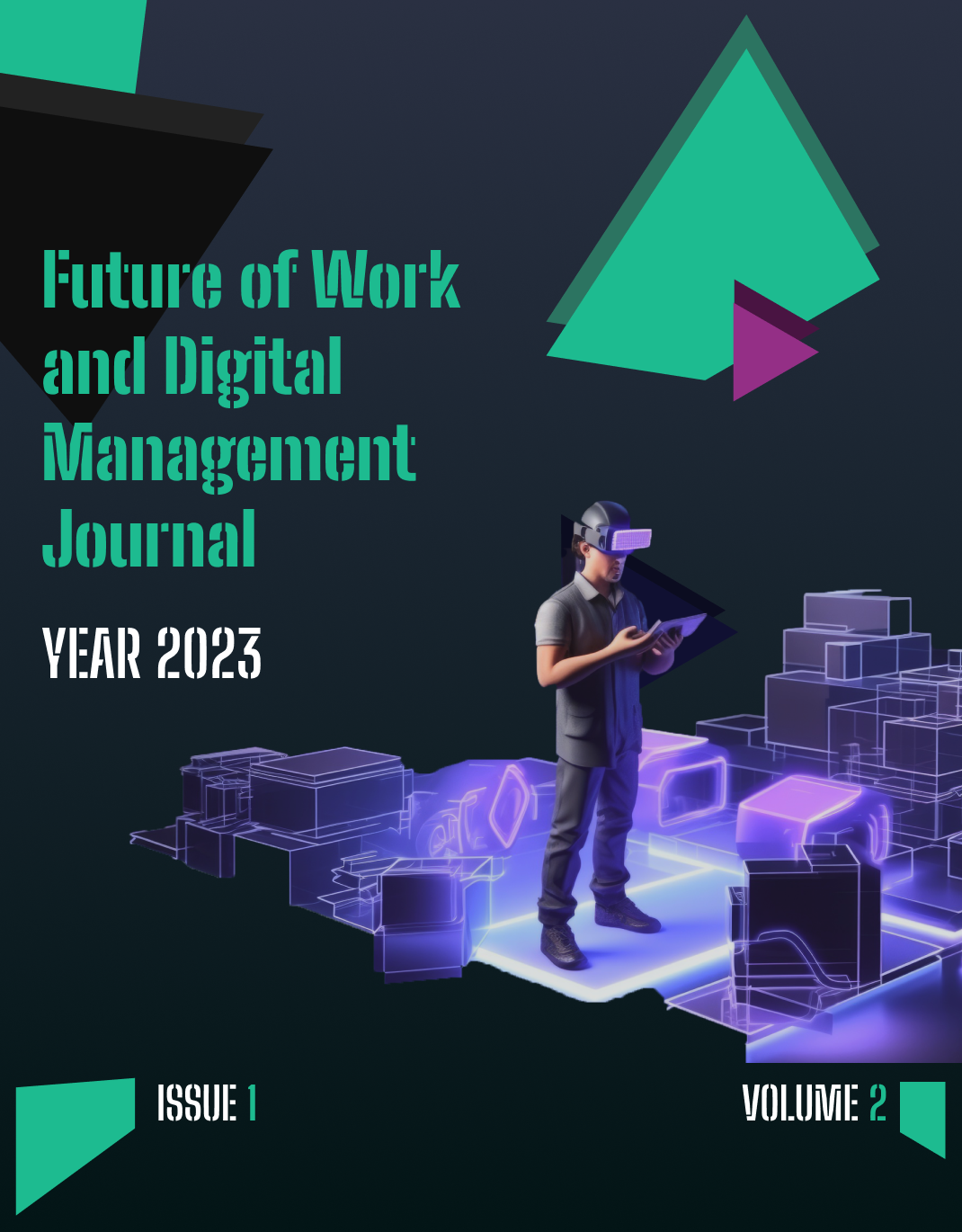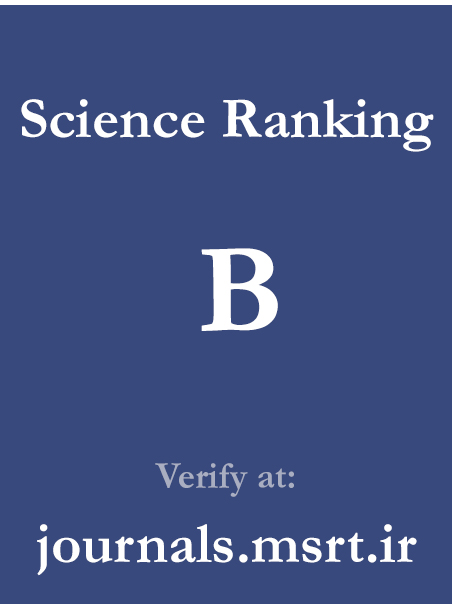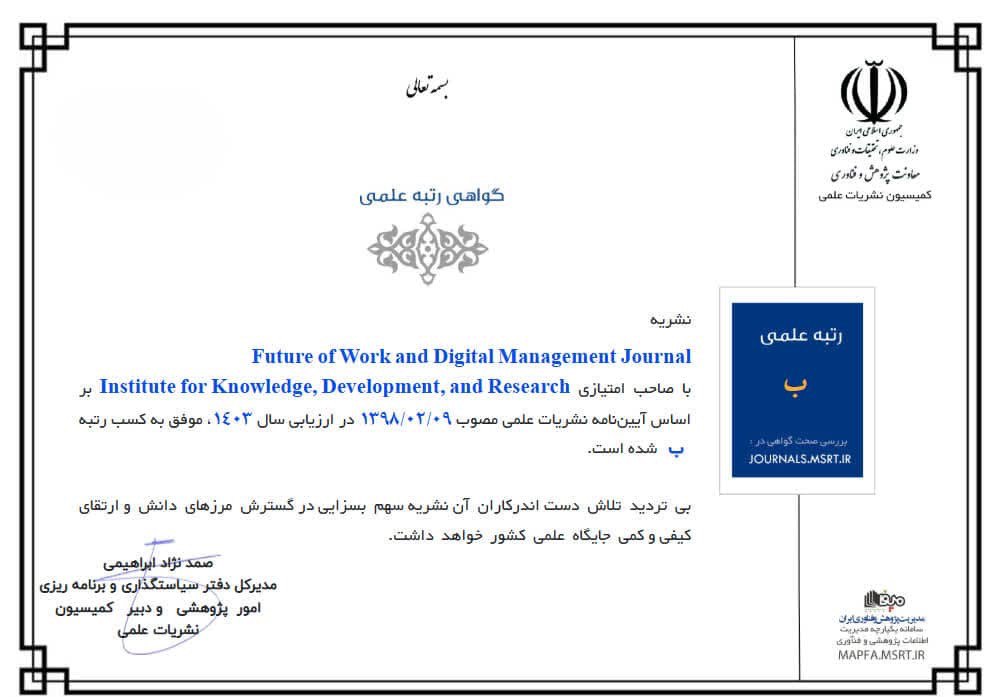Identifying the Structural Dimensions of Digital Governance in Large Organizations
Keywords:
Digital governance, organizational architecture, regulatory alignment, technological integration, large organizationsAbstract
This study aimed to explore and identify the core structural dimensions that shape digital governance in large organizations operating within complex institutional and regulatory environments. A qualitative research design was employed using semi-structured, in-depth interviews with 17 professionals from large organizations based in Tehran, all of whom were directly involved in digital transformation or governance roles. Participants were selected through purposive sampling, and data collection continued until theoretical saturation was achieved. Interviews were transcribed verbatim and analyzed thematically using NVivo software. The analysis involved open coding, axial coding, and category formation through constant comparison, with a focus on capturing structural factors affecting digital governance practices. Three primary themes emerged from the analysis: (1) Organizational Architecture, including subthemes such as centralization, leadership structures, formal digital units, and interdepartmental coordination; (2) Regulatory Alignment, encompassing compliance with national digital policies, internal digital policy frameworks, and risk governance mechanisms; and (3) Technological Integration Capacity, reflecting IT infrastructure readiness, interoperability challenges, and digital tool adoption. The findings indicate that effective digital governance depends on the interdependence of these dimensions, with formalized leadership roles, regulatory synchronization, and scalable digital systems acting as critical enablers. The study highlights that successful digital governance in large organizations requires the deliberate structuring of internal systems that align organizational roles, policies, and technologies. Governance is most effective when digital leadership is institutionalized, compliance frameworks are embedded, and technological platforms are interoperable and adaptable. These insights offer a practical roadmap for organizations seeking to build resilient and responsive governance systems in the digital age.
Downloads
References
[1] R. Capurro, R. Fiorentino, R. M. Galeotti, and S. Garzella, "The Impact of Digitalization and Sustainability on Governance Structures and Corporate Communication: A Cross-Industry and Cross-Country Approach," Sustainability, vol. 15, no. 3, p. 2064, 2023, doi: 10.3390/su15032064.
[2] S. J. Lin, K. Xu, K. Wang, Y. Huang, Y. Yang, and H. Liao, "The Intervention and Impact of Digital Society on the Governance of Dual Equity Structure in Enterprises," Revista de Cercetare si Interventie Sociala, vol. 86, pp. 34-45, 2024, doi: 10.33788/rcis.86.3.
[3] J. Keller, R. Lasch, and S. Matook, "Governance of Digital Supply Networks: Systematic Literature Review and Research Agenda," Australian Journal of Management, vol. 49, no. 4, pp. 740-789, 2023, doi: 10.1177/03128962231175702.
[4] E. M. Luciano, F. P. d. Santos, G. C. Wiedenhöft, and R. D. Silva, "Identifying Barriers to the Adoption of the Brazilian Digital Governance Policy and the Role of Collaborative Governance," Administração Pública E Gestão Social, 2024, doi: 10.21118/apgs.v16i4.15402.
[5] K. Kristensen and K. N. Andersen, "C-Suite Leadership of Digital Government," Digital Government Research and Practice, vol. 4, no. 1, pp. 1-23, 2023, doi: 10.1145/3580000.
[6] Z. Lachana, Y. Charalabidis, and P. Keramidis, "On the Structure of the Digital Governance Domain," pp. 73-99, 2022, doi: 10.1007/978-3-030-92945-9_4.
[7] Y. Chen, "Does Digital Government Help Local Governments "Cut Costs"?," Academic Journal of Management and Social Sciences, vol. 8, no. 3, pp. 68-71, 2024, doi: 10.54097/mvgxek26.
[8] a. Ngurah Wisnu Murthi Et, "The Role of Government and Digitalization (ICT) in Fostering Equitable Growth at the Coastal Village of Badung, Bali," TJJPT, vol. 44, no. 4, pp. 7044-7054, 2023, doi: 10.52783/tjjpt.v44.i4.2538.
[9] M. Wang, "The Formation Causes and Governance Strategies of Digital Formalism in Township Government From the Perspective of Policy Implementation Process," Urban Studies and Public Administration, vol. 7, no. 1, p. p15, 2024, doi: 10.22158/uspa.v7n1p15.
[10] T. Makasarashvili and G. Giguashvili, "Peculiarities and Threats of Introducing Digital Government in Georgia," Грааль Науки, no. 41, pp. 130-135, 2024, doi: 10.36074/grail-of-science.05.07.2024.017.
[11] A. A. Nasef, H. Onallah, M. Jwad, and M. Elsaraiti, "Institutional Structural Reform by Implementing the Digital Governance," Revizor, vol. 25, no. 99, pp. 35-50, 2022, doi: 10.56362/rev2299035n.
[12] T. Zhang, J. Jiang, and S. Li, "Research and Application of Governance System Development of Digital Government," Advances in Economics and Management Research, vol. 5, no. 1, p. 34, 2023, doi: 10.56028/aemr.5.1.34.2023.
[13] Y. Guo, "Long-Term-Oriented Cultural Value," International Journal of Information Systems in the Service Sector, vol. 14, no. 2, pp. 1-15, 2022, doi: 10.4018/ijisss.313380.
[14] D. Tan and I. Fong, "Analysis of the Impact of Government Governance and Law on the Conceptualization, Creation and Structure of Digital Music From the Perspective of Local Self- Government," Lex Localis - Journal of Local Self-Government, vol. 22, no. 4, pp. 1-16, 2024, doi: 10.52152/22.4.1-16(2024).
[15] Y. Lan, "Reducing Burden and Empowering: Discussion on Digital Transformation Path of Grass-Roots Governance," The Frontiers of Society Science and Technology, vol. 5, no. 8, 2023, doi: 10.25236/fsst.2023.050803.
[16] M. U. Albab and I. F. Agustina, "Digital Official Letter Management Using E-Buddy Sidoarjo Application," Indonesian Journal of Law and Economics Review, vol. 19, no. 4, 2024, doi: 10.21070/ijler.v19i4.1188.
[17] J. Hou, X. Li, F. Chen, and B. Hou, "The Effect of Digital Economy on Rural Environmental Governance: Evidence From China," Agriculture, vol. 14, no. 11, p. 1974, 2024, doi: 10.3390/agriculture14111974.
[18] B. Qi and Q. I. Tian-zhen, "Research on the Development of Rural Governance Based on Digital Technology," Agricultural & Forestry Economics and Management, vol. 6, no. 3, 2023, doi: 10.23977/agrfem.2023.060309.
[19] Y. Wang, X. Zhang, F. Lin, and M. Peng, "The Role of Digital Governance on Carbon Emission Performance: Evidence From the Cities in Yangtze River Delta, China," Environmental Research Communications, vol. 5, no. 8, p. 085013, 2023, doi: 10.1088/2515-7620/acf2dc.
[20] T. Huang, "Research on the Mechanism and Path of Digital Economy Promoting Green Development of the Agricultural Sector," The Frontiers of Society Science and Technology, vol. 5, no. 4, 2023, doi: 10.25236/fsst.2023.050411.
[21] F. Niu, "The Role of the Digital Economy in Rebuilding and Maintaining Social Governance Mechanisms," Frontiers in Public Health, vol. 9, 2022, doi: 10.3389/fpubh.2021.819727.
Downloads
Published
Submitted
Revised
Accepted
Issue
Section
License

This work is licensed under a Creative Commons Attribution-NonCommercial 4.0 International License.








